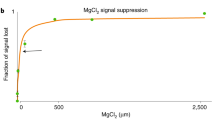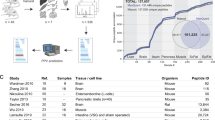Abstract
In targeted proteomics it is critical that peptides are not only proteotypic but also accurately represent the level of the protein (quantotypic). Numerous approaches are used to identify proteotypic peptides, but quantotypic properties are rarely assessed. We show that measuring ratios of proteotypic peptides across biological samples can be used to empirically identify peptides with good quantotypic properties. We applied this technique to identify quantotypic peptides for 21% of the human kinome.
This is a preview of subscription content, access via your institution
Access options
Subscribe to this journal
Receive 12 print issues and online access
$259.00 per year
only $21.58 per issue
Buy this article
- Purchase on Springer Link
- Instant access to full article PDF
Prices may be subject to local taxes which are calculated during checkout



Similar content being viewed by others
References
Picotti, P., Bodenmiller, B. & Aebersold, R. Nat. Methods 10, 24–27 (2013).
Gillette, M.A. & Carr, S.A. Nat. Methods 10, 28–34 (2013).
Domon, B. & Aebersold, R. Nat. Biotechnol. 28, 710–721 (2010).
Lange, V., Picotti, P., Domon, B. & Aebersold, R. Mol. Syst. Biol. 4, 222 (2008).
Kuster, B., Schirle, M., Mallick, P. & Aebersold, R. Nat. Rev. Mol. Cell Biol. 6, 577–583 (2005).
Vizcaíno, J.A. et al. Nucleic Acids Res. 41, D1063–D1069 (2013).
Craig, R., Cortens, J.P. & Beavis, R.C. J. Proteome Res. 3, 1234–1242 (2004).
Deutsch, E.W., Lam, H. & Aebersold, R. EMBO Rep. 9, 429–434 (2008).
Picotti, P. et al. Nat. Methods 5, 913–914 (2008).
Mallick, P. et al. Nat. Biotechnol. 25, 125–131 (2007).
Picotti, P. et al. Nat. Methods 7, 43–46 (2010).
Stergachis, A.B., MacLean, B., Lee, K., Stamatoyannopoulos, J.A. & MacCoss, M.J. Nat. Methods 8, 1041–1043 (2011).
Brownridge, P. et al. Proteomics 11, 2957–2970 (2011).
Patricelli, M.P. et al. Biochemistry 46, 350–358 (2007).
Patricelli, M.P. et al. Chem. Biol. 18, 699–710 (2011).
Krokhin, O.V. Mol. Cell. Proteomics 3, 908–919 (2004).
Ludwig, C., Claassen, M., Schmidt, A. & Aebersold, R. Mol. Cell. Proteomics 11, M111.013987 (2012).
Käll, L., Canterbury, J.D., Weston, J., Noble, W.S. & MacCoss, M.J. Nat. Methods 4, 923–925 (2007).
Vizcaíno, J.A. et al. Nat. Biotechnol. 32, 223–226 (2014).
MacLean, B. et al. Anal. Chem. 82, 10116–10124 (2010).
MacLean, B. et al. Bioinformatics 26, 966–968 (2010).
Farrah, T. et al. Proteomics 12, 1170–1175 (2012).
Escher, C. et al. Proteomics 12, 1111–1121 (2012).
Cook, R.D. & Weisberg, S. Residuals and Influence in Regression (Chapman and Hall, 1982).
Acknowledgements
This work is supported by a Biotechnology and Biological Sciences Research Council (BBSRC)/Pfizer CASE Studentship (BB/I532329/1; J.W.) and a Cancer Research UK Career Establishment Award (C37293/A12905; C.J.). We thank colleagues in the Cell Communication Team (The Institute of Cancer Research) for valuable input and useful discussions and the PRIDE team (The European Bioinformatics Institute, UK) for help with data submission.
Author information
Authors and Affiliations
Contributions
J.D.W. and C.J. conceived the idea and designed experiments. J.D.W. performed all SRM assays. J.D.W. and J.S. analyzed samples for discovery analysis. Y.Y. and J.D.W. developed and applied computational analysis techniques. J.D.W., C.J. and Y.Y. analyzed data. J.D.W. and C.J. wrote the manuscript. C.J. oversaw the project.
Corresponding author
Ethics declarations
Competing interests
The authors declare no competing financial interests.
Integrated supplementary information
Supplementary Figure 1 Overlap of identified protein kinases between discovery analyses using desthiobiotin nucleotide probes.
Venn diagram of identified protein kinases at (a) protein level and (b) peptide level. The blue and red circles represent the fraction from ATP and ADP enriched samples, respectively.
Supplementary Figure 2 Validation of proteotypic peptides.
(a) Plot of measured peptide retention times (synthetic peptides) against predicted hydrophobicity values from SSRCalc 3.0 (100 Å). (b) Density plot showing the distribution of the measured iRT for synthetic peptides compared to their endogenous counterparts (ΔiRT). The mean value (3.5) is highlighted with a red dotted line, and tolerances of +/- 10 iRT values are shown with dashed red lines. (c) Plot of iRT values measured for synthetic peptides alone and in endogenous (enriched) samples. (d) Plot summarising the thresholds set for validation criteria. A Pearson correlation coefficient >0.8 and ΔiRT +/- 10 from the mean are illustrated with dashed lines. Peptides within these tolerances are colored in black, and those outside of these are grey. The number of peptides (n), correlation coefficient (R2) and P-values for a linear regression model is given.
Supplementary Figure 3 Statistical analysis of quantotypic peptide properties.
(a) Box plots representing the proportion of quantotypic peptides following resampling analysis of data from group 2 (from Fig. 2b). Correlation analysis with resampling was conducted with increasing numbers of total cell lines. The fitted red line is a prediction from a cubic smoothing spline model. The number of peptides included in this analysis is provided. (b) ROC curve showing the performance when the first group of six cell lines are used to predict quantotypic peptides in the second group. (c) A Q-Q plot comparing the distribution of intra-protein peptide correlations between group 1 and 2. The identity line is shown in red. (d,e and f) Heat map of assigned quantotypic peptides. The number of successfully identified quantotypic peptides are plotted against the total number of proteotypic peptides evaluated. The color code represents the fraction of kinases within each category. (g) ROC analysis comparing the agreement between n = 3-11 and n = 12. Color coding and AUC values are provided in the legend. (h) Box plots showing the distributions of protein confidence scores for each group of cell lines.
Supplementary Figure 4 Determining quantotypic behavior of proteotypic peptides across 109 kinases.
The matrix displays proteotypic peptides with highly correlated levels (P ≰ 0.05, shown in red) across the 12 cell lines. Peptides that display poor correlation are shown in blue. Peptides are grouped by protein along each axis so that peptides within the same kinase are represented diagonally.
Supplementary Figure 5 Evaluation of peptide quantotypic behavior following growth factor stimulation.
(a) Western blot analysis of MiaPaCa2 cells stimulated with either EGF or IGF-II for 5, 10 or 30 minutes. Signalling activation is shown by an increase in phosphotyrosine levels, and GAPDH is shown as a loading control. (b) Plots displaying the relative intensity (log transformed) of all quantotypic peptides between all stimulated conditions (bottom left). The correlation coefficient (R2) of each of these is provided in the top right and the distributions in the diagonal pane. Peptides that were identified as outliers are shown in red. (c) Plot showing the Cook’s distance of each peptide calculated from a linear regression across all stimulation conditions. Peptide sequences are plotted onto the graph. The threshold used (see Online Methods) is shown by a dashed red line, and a very strict threshold of 0.1 is shown with a dotted red line.
Supplementary Figure 6 Guide to the gel-based fractionation for SRM analysis of protein kinases directly from cell lysates.
On the left hand side is a depiction of the molecular weight ladder we use as a reference for cutting gel band slices (Thermo Scientific, cat # 26616). The gel is cut into 8 slices (fractions) where specific kinases are targeted, as shown on the right hand side.
Supplementary Figure 7 Statistical summary of quantotypic SRM analysis in cell lysate.
(a) Histogram showing the number of quantotypic peptides per protein used to determine the relative abundance of protein kinases across the six pancreatic cancer cell lines. The absolute numbers in each category are given within each bar. (b) Histogram showing the distribution of the log10 transformed protein areas measured across all cell lines. (c,d) Box plots showing the distribution of technical CVs in each cell line for each biological repeat for both peptides (c) and proteins (d). (e) Plot to show measured log10 transformed areas for peptides across both technical repeats. The first biological replicate is plotted in black and the second in grey. (f) Plot to show measured protein areas across both biological replicates. A linear regression line is plotted (red line) and the number of protein measurements (n), correlation coefficient (R2) and P-value is given. *In the version of this file originally posted online, Supplementary Figure 7e,f was missing data points. The error has been corrected as of 19 November 2014.
Supplementary Figure 8 Relative abundance of 83 protein kinases across six pancreatic cancer cell lines.
Peptide intensities were averaged across each kinase, and each value was log10 transformed and displayed as a heat map of relative abundance. Kinases, by row, are labelled as well as cell lines, by column. The color key is shown. Dendograms are also shown across cell lines, and across kinases.
Supplementary Figure 9 Comparison of quantotypic and nonquantotypic peptide statistics.
(a) Histogram of all measured areas from quantotypic (white) and non-quantotypic (grey) peptides. (b,c) Box plots showing technical (b) and biological (c) CV for all quantotypic and non-quantotypic peptides measured from human total cell lysate. The number of total peptide measurements (n) in each group is shown.
Supplementary information
Supplementary Text and Figures
Supplementary Figures 1–9 and Supplementary Results (PDF 1314 kb)
Supplementary Table 1
Transitions for all detected peptides by SRM. The table contains: Peptide Sequence, Protein Name, Precursor and Product m/z, Collision Energy, Precursor and Product Charge, and the type of product ion. (XLS 592 kb)
Supplementary Table 2
Summary of peptide validation using synthetic peptides. For each peptide the sequence, protein name, iRT and ΔiRT values, P-values and Pearson correlation coefficients from relative ion distribution comparisons are given. (XLS 77 kb)
Supplementary Table 3
Peptide correlations across 12 cell lines. This table provides a list of all peptides included in the quantotypic analysis, with their associated protein names and individual intra-protein peptide correlations. (XLS 83 kb)
Supplementary Table 4
Peptide quantotypic ranking. (XLS 53 kb)
Supplementary Table 5
Protein confidence scores. Confidence scores were calculated based on the quantotypic analysis across 12 cell lines. (XLS 22 kb)
Supplementary Software
R code, datasets and annotated Sweave file for quantotypic peptide analysis (ZIP 4155 kb)
Rights and permissions
About this article
Cite this article
Worboys, J., Sinclair, J., Yuan, Y. et al. Systematic evaluation of quantotypic peptides for targeted analysis of the human kinome. Nat Methods 11, 1041–1044 (2014). https://doi.org/10.1038/nmeth.3072
Received:
Accepted:
Published:
Issue Date:
DOI: https://doi.org/10.1038/nmeth.3072



